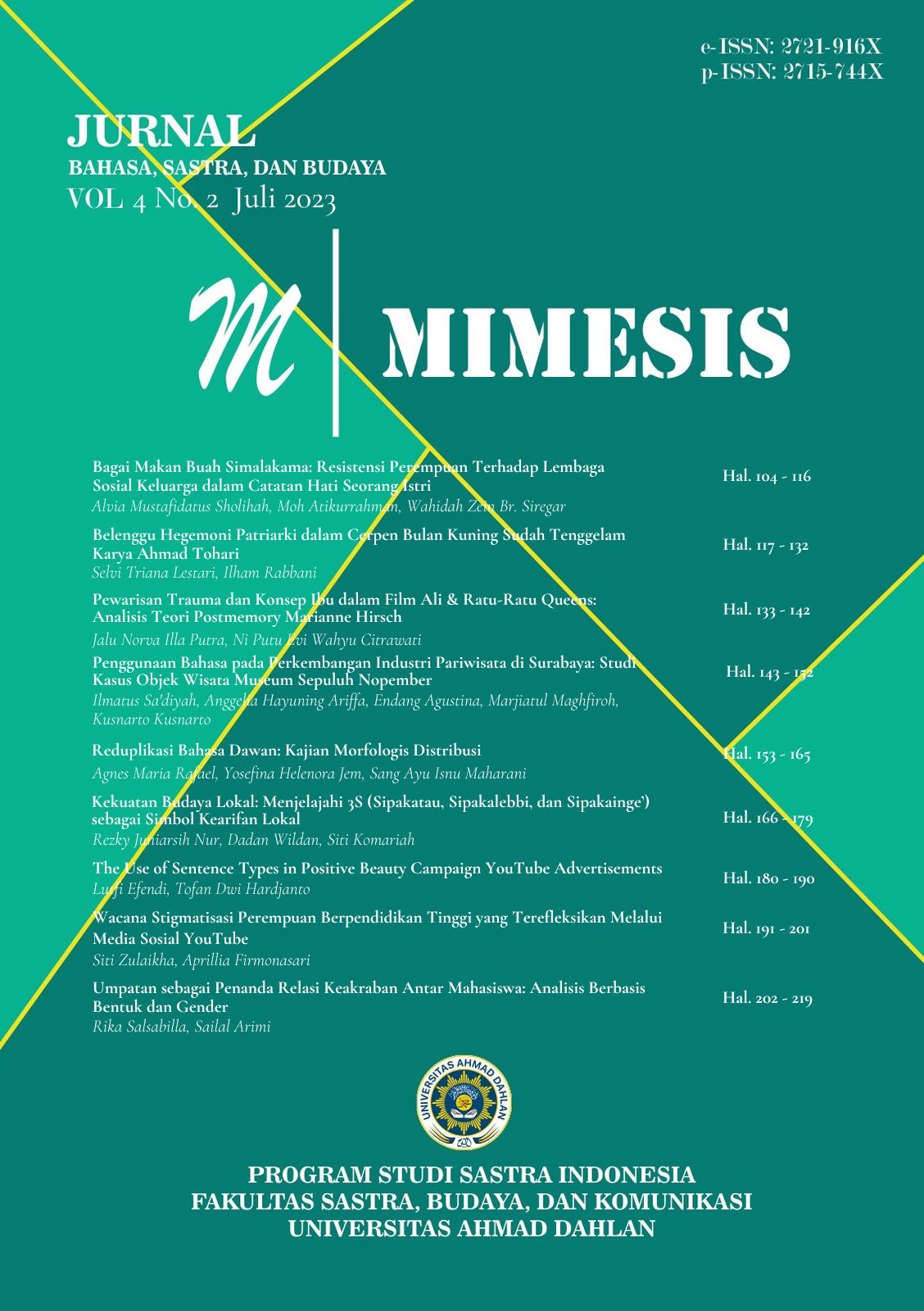Bagai Makan Buah Simalakama: Resistensi Perempuan Terhadap Lembaga Sosial Keluarga dalam Catatan Hati Seorang Istri
DOI:
https://doi.org/10.12928/mms.v4i2.7401Keywords:
Asma Nadia, Catatan Hati Seorang Istri, Feminism, Naomi Wolf, ResistanceAbstract
This article aims to describe the figure of feminine resistance by depicting a wife's life in Catatan Hati Seorang Istri (Notes of a Wife's Heart). In Asma Nadia's prose, the narrative highlights domestic problems often experienced by third-world women who usually are faced with a dilemma between matters of domestic space and access to public space. This article refers to Naomi Wolf's view that feminism must fulfill if it is to be called a resistance movement: independence, altruism, persistence, courage, resilience, and willingness to sacrifice. The results of the study show that Wolf's view of power feminism is in the form of women's resistance figures, namely: (1) awareness of the power of women as independent women; (2) the way of thinking and acting of female characters who prioritize the interests of their husbands and children rather than their interests as strength; (3) firm and sure of the chosen decision; (4) dare to voice opinions on their choices; (5) the struggle of a woman when faced with a dilemma in the domestic and public spheres; and (6) sacrifice for the decision of the path of his own choice of life.
References
Adzhani, S. A. (2022). Backlash As a Counter Assault to Woman ’ s Progress : Feminism Reading on Habiburrahman El Shirazy’s Novel Cinta Suci Zahrana. SULUK: Jurnal Bahasa, Sastra, Dan Budaya 4(1), 70–79.
Amaliah, R., Shofah, N. A., & Tawakal, C. S. (2022). Sangkan Paraning Dumadi: The Image of Women, Hysteria, and Patriarchal Chains in Intan Paramadhita’s Short Story. SULUK: Jurnal Bahasa, Sastra, Dan Budaya, 4(1), 14–23.
Annatasya, B. F., & Saksono, L. (2021). Resistensi perempuan dalam film nur eine frau karya sherry hormann: kajian feminisme kekuasaan Naomi Wolf. IDENTITAET, 10(2), 118-128.
Atikurrahman, M., Siregar, W. Z. B., & An Adzhani, S. (2023). Belenggu Maskulinitas dalam Kultur Matrilineal Minangkabau: Ambivalensi Sitti Nurbaya dan Beberapa Citra Kolosal Gender pada Roman Marah Roesli. SULUK: Jurnal Bahasa, Sastra, Dan Budaya, 4(2), 94–104.
Fawaid, A. (2021). Logic Of Phallus And Object Of Desire: Rethinking ‘Masculinities’ in Literary Works of Contemporary Indonesian Woman Writers. SULUK: Jurnal Bahasa, Sastra, Dan Budaya, 3(2), 140–149.
Gula, Richard M. Etika Pastoral. (2009). Terjemahan oleh William Chang. Penerbit: Kanisius. Yogyakarta.
Gunawan, D. (2022). Perang Dan Liyan: Kajian Feminisme Eksistensialis Dalam Novel Lampuki Karya Arafat Nur. MIMESIS, 3(2), 86–100.
Hakika, W. F. (2021). Citra Perempuan Dalam Novel Catatan Hati Seorang Istri Karya Asma Nadia. (Doctoral dissertation, Universitas Mataram).
Hearty, F. (2015). Keadilan jender: perspektif feminis Muslim dalam sastra Timur Tengah. Yayasan Pustaka Obor Indonesia.
Lacan, J. (2007). Écrits: A Selection (B. Fink, Ed.). W. W. Norton & Company.
Maghfiroh, D. L., & Zawawi, M. (2020). Resistensi Perempuan dalam Film For Sama: Kajian Timur Tengah Perspektif Feminisme Naomi Wolf. NUSA: Jurnal Ilmu Bahasa dan Sastra, 15(4), 506-520.
Muslimin, M. F. (2019). Perempuan Dalam Novel Destroy,She Said Karya Marguerite Duras: Analisis Feminisme Kekuasaan Naomi Wolf. Jurnal Undas, Fakultas Sastra, Universitas Muslim Indonesia, 15(2), 123-134.
Nadia, A. (2011). New Catatan Hati Seorang Istri (Thenita (ed.)). AsmaNadia Publishing House. Depok.
Neila, R. (2018). Psikologi untuk Indonesia Tangguh dan Bahagia. Gadjah Mada University Press.
Novarisa, G. (2019). Dominasi patriarki berbentuk kekerasan simbolik terhadap perempuan pada sinetron. Bricolage: Jurnal Magister Ilmu Komunikasi, 5(02), 195-211.
Purnami, K., & Pramono, D. (2021). Eksistensi Perempuan dalam Novel Kitab Omong Kosong karya Seno Gumira Ajidarma: Kajian Feminisme Eksistensialis Simone de Beauvoir. MIMESIS, 2(1), 54-62.
Purwati, A., & Kusniati, T. (2017). Pembelajaran Sastra Indonesia Berbasis Kearifan Lokal. UMM Press.
Sayekti, H. O., & Fitria, S. (2023). Beauty Standard as a Construction of Woman Objectification in Trisha R. Thomas’s Nappily Ever After. SULUK: Jurnal Bahasa, Sastra, Dan Budaya, 4(2), 157–168.
Sukmawati, W. M. I. (2019). Representasi Gender Dalam Novel “Catatan Hati Seorang Istri” Karya Asma Nadia (Kajian Feminisme). EDU-KATA, 5(2), 187–194.
Sulityowati, I. (2003). Perempuan di antara Berbagai Pilihan Hukum. Yayasan Obor Indonesia.
Velisya, V., & Efendi, E. (2021). Konflik Batin Tokoh Utama Perempuan Pada Novel Catatan Hati Seorang Istri Karya Asmanadia Dalam Tinjauan Psikologi Sastra. JURNAL SENARAI BASTRA, 1(2), 129-135.
Wardani, F. (2022). Nilai-nilai Dakwah dalam Novel Catatan Hati Seorang Istri Menurut Perspektif Komunikasi Islam. (Doctoral dissertation, IAIN Bone).
Wati, A., Fakihuddin, L., & Al-Pansori, M. J. (2021). Realitas Harmoni Dalam Novel “Catatan Hati Seorang Istri” Karya Asma Nadia. ALINEA: Jurnal Bahasa, Sastra dan Pengajarannya, 1(1), 10-18.
Wening, U. (2018). Dari Doing ke Undoing Gender. Gadjah Mada University Press.
Wolf, N. (1993). Fire With Fire. Published by Vintage.
Wolf, N. (1997). Geger Gender. Penerbit: Pustaka Semesta Press. Yogyakarta.
Zunaida, D. (2016). Rendahnya persepsi gender mahasiswa di malang. Jurnal Penelitian Pendidikan, 8(2), 1251–1310.
Downloads
Published
Issue
Section
License
Copyright (c) 2023 Alvia Mustafidatus Sholihah, Moh Atikurrahman, Wahidah Zein Br. Siregar

This work is licensed under a Creative Commons Attribution-ShareAlike 4.0 International License.
License and Copyright Agreement
In submitting the manuscript to the journal, the authors certify that:
- They are authorized by their co-authors to enter into these arrangements.
- The work described has not been formally published before, except in the form of an abstract or as part of a published lecture, review, thesis, or overlay journal.
- That it is not under consideration for publication elsewhere,
- That its publication has been approved by all the author(s) and by the responsible authorities tacitly or explicitly of the institutes where the work has been carried out.
- They secure the right to reproduce any material that has already been published or copyrighted elsewhere.
- They agree to the following license and copyright agreement.
Copyright
Authors who publish with Mimesis agree to the following terms:
- Authors retain copyright and grant the journal right of first publication with the work simultaneously licensed under a Creative Commons Attribution License (CC BY-SA 4.0) that allows others to share the work with an acknowledgment of the work's authorship and initial publication in this journal.
- Authors are able to enter into separate, additional contractual arrangements for the non-exclusive distribution of the journal's published version of the work (e.g., post it to an institutional repository or publish it in a book), with an acknowledgment of its initial publication in this journal.
- Authors are permitted and encouraged to post their work online (e.g., in institutional repositories or on their website) prior to and during the submission process, as it can lead to productive exchanges, as well as earlier and greater citation of published work.











